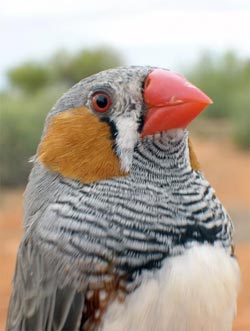Sexy sons thanks to mom

A Zebra Finch male displaying his color ornaments.
In Zebra Finches, as in most other bird species, both parents contribute to offspring rearing. The social partner of a female, however, is not always the biological father of the young. If the opportunity arises, females will choose to pair with partners other than their primary mate – with the interesting result that the offspring of different fathers have different qualities. And, as evolutionary ecologists from the University of Zurich and biologists from Macquarie University in Sydney have discovered, offspring sired by an extra-pair partner develop larger color ornaments and are more attractive to females than their social half-brothers.
Extra-pair males are not more attractive
Up to now, the quality differences between social and extra-pair offspring have generally been assumed to reflect the genetic superiority of the extra-pair male. Indeed, females are believed to engage in extra-pair copulation with genetically superior males to obtain better genes for their offspring. Now, Barbara Tschirren, professor for evolutionary ecology at the University of Zurich, and her team have challenged the idea of the exceptional male. In a study published in «Proceedings of the Royal Society» the researchers demonstrate that – despite the observed quality differences – the fathers of attractive sons are neither better looking nor genetically superior.
The first eggs receive preferential treatment
According to the study, attractive sons are not the result of exceptional genes; rather, their enhanced ornamentation is due to the mother’s investment in the eggs. Tschirren was able to demonstrate that maternal resource investment decreases steadily over the course of the laying sequence of a Zebra Finch, with eggs laid early in a clutch being larger and containing more nutrients and hormones. Favoring early eggs and the first hatchlings is a worthwhile investment for the mother as these offspring have a demonstrably higher chance of survival. «It appears that there is strong competition among males to fertilize these valuable eggs early in a female’s laying sequence», explains lead author Barbara Tschirren. «They try to exploit the female’s egg investment bias to ensure a head start for their own offspring.» She hypothesizes that sperm competition might decide the battle, with males with faster sperm being able to fertilize the most valuable eggs.
Literature:
Barbara Tschirren, Erik Postma, Alison N. Rutstein, Simon C. Griffith: When mothers make sons sexy: Maternal effects contribute to the increased sexual attractiveness of extra-pair offspring, in: Proceedings of the Royal Society B, 28 September 2011, DOI:10.1098/rspb.2011.1543
Contact:
Prof. Dr. Barbara Tschirren
University of Zurich
Institute of Evolutionary Biology and Environmental Studies
Phone: +41 44 635 47 77
Media Contact
More Information:
http://www.uzh.chAll latest news from the category: Life Sciences and Chemistry
Articles and reports from the Life Sciences and chemistry area deal with applied and basic research into modern biology, chemistry and human medicine.
Valuable information can be found on a range of life sciences fields including bacteriology, biochemistry, bionics, bioinformatics, biophysics, biotechnology, genetics, geobotany, human biology, marine biology, microbiology, molecular biology, cellular biology, zoology, bioinorganic chemistry, microchemistry and environmental chemistry.
Newest articles

Bringing bio-inspired robots to life
Nebraska researcher Eric Markvicka gets NSF CAREER Award to pursue manufacture of novel materials for soft robotics and stretchable electronics. Engineers are increasingly eager to develop robots that mimic the…

Bella moths use poison to attract mates
Scientists are closer to finding out how. Pyrrolizidine alkaloids are as bitter and toxic as they are hard to pronounce. They’re produced by several different types of plants and are…

AI tool creates ‘synthetic’ images of cells
…for enhanced microscopy analysis. Observing individual cells through microscopes can reveal a range of important cell biological phenomena that frequently play a role in human diseases, but the process of…





















